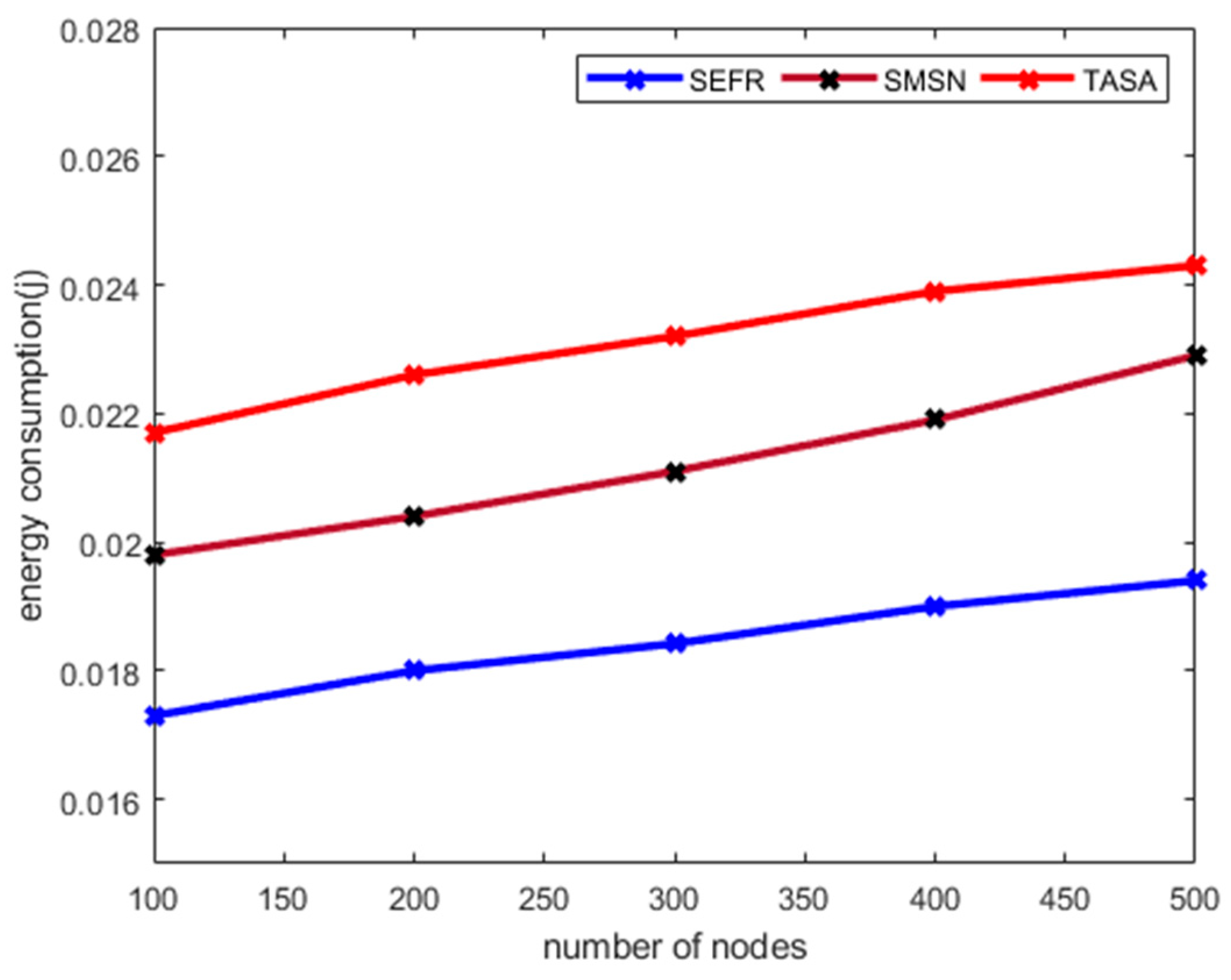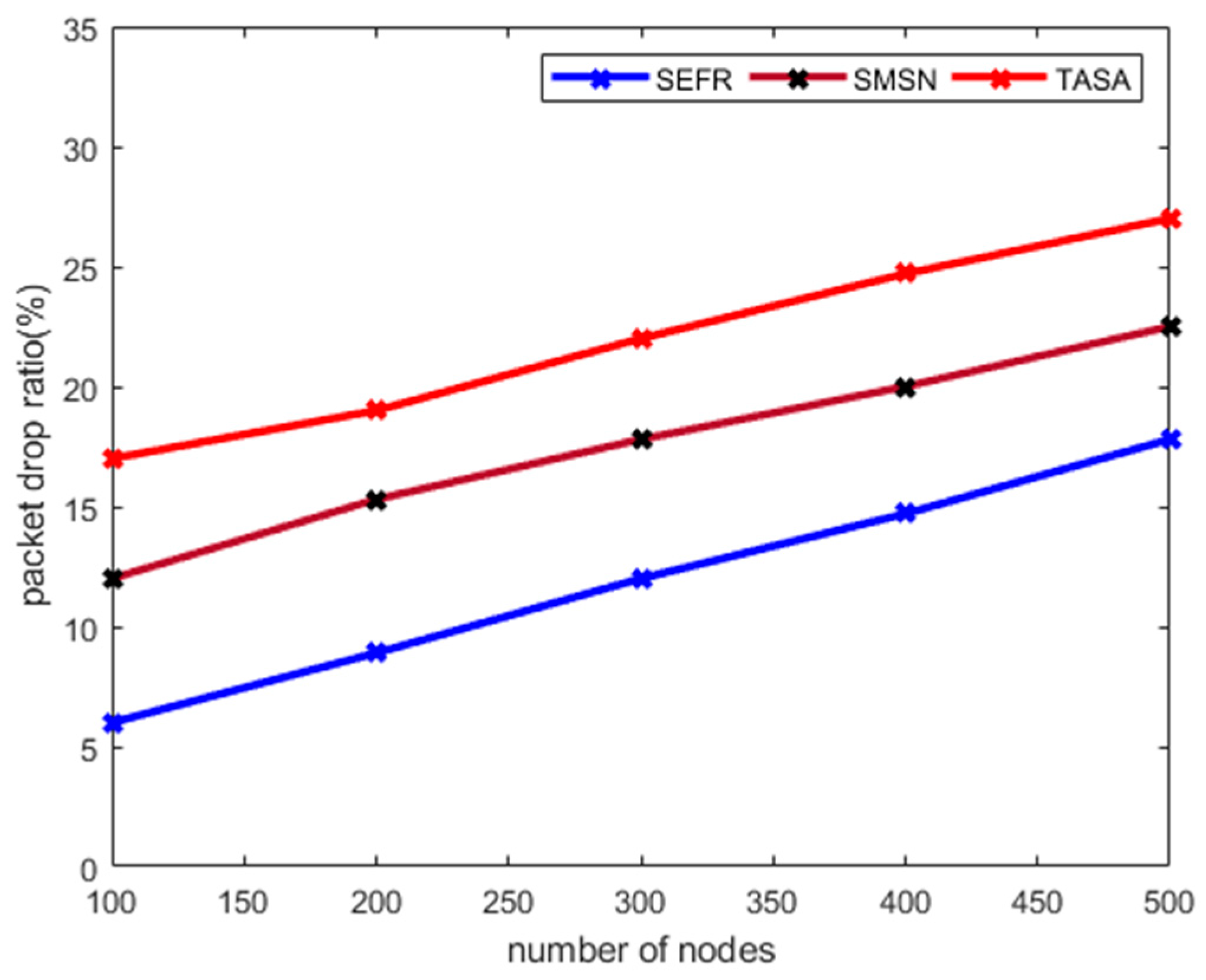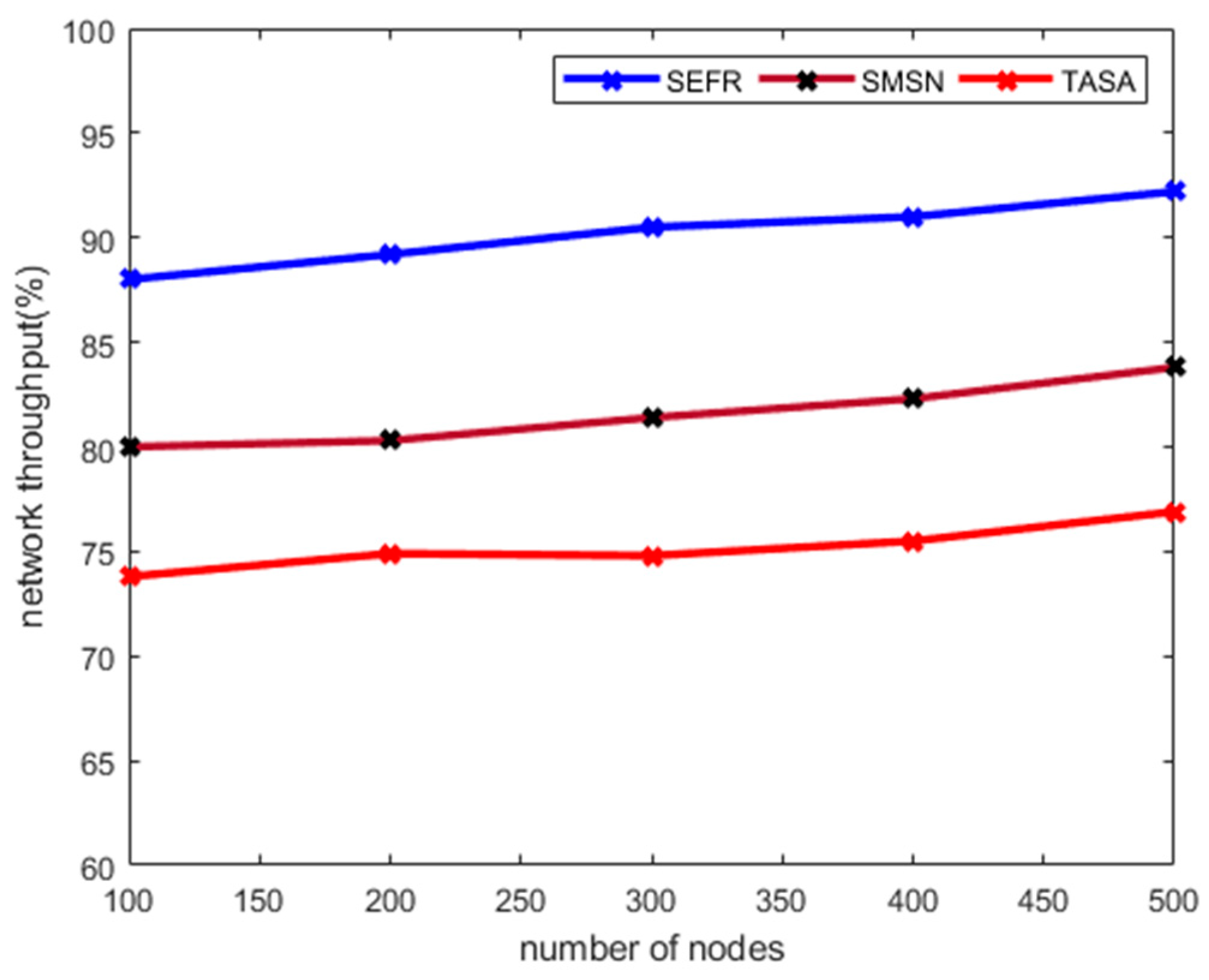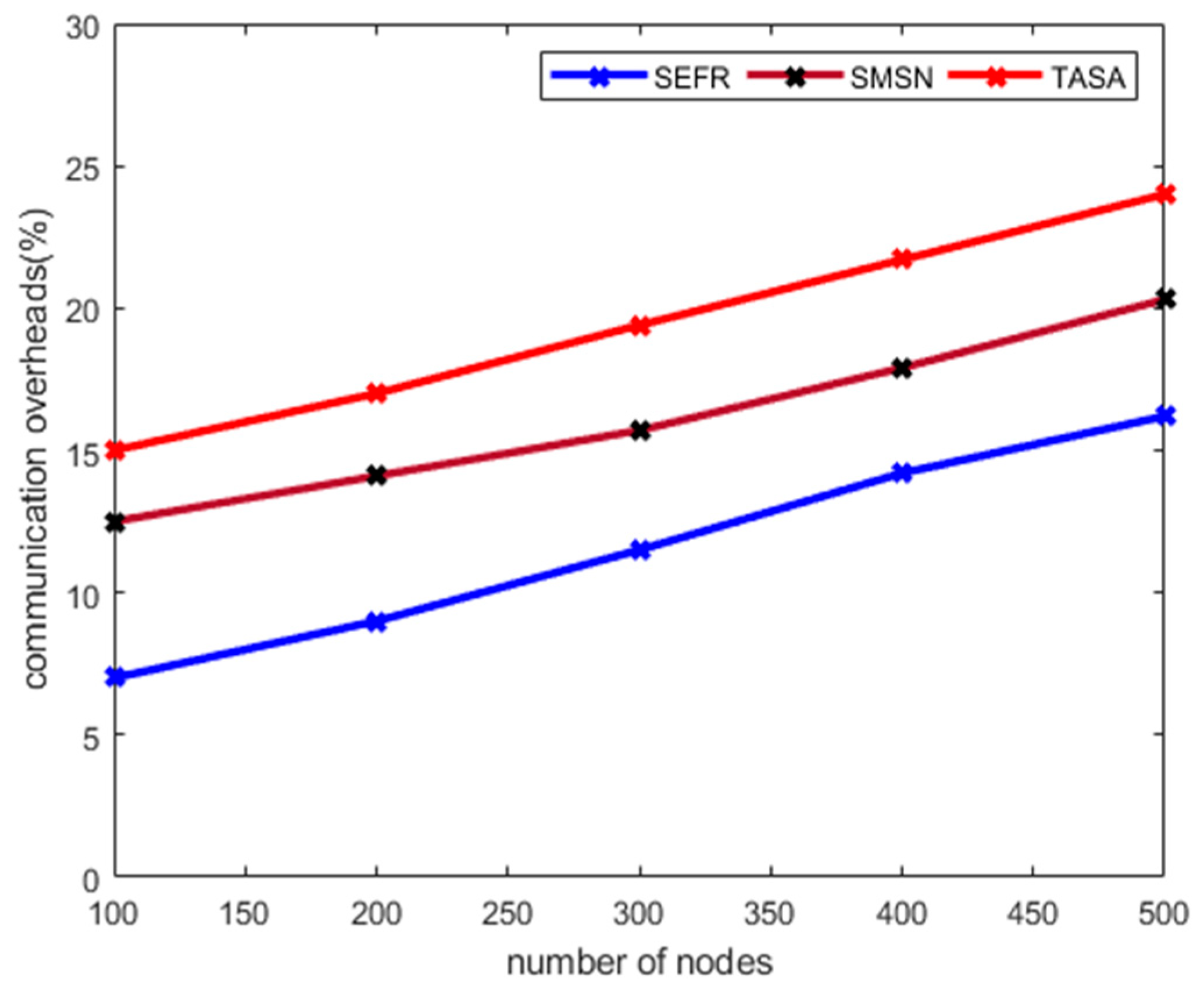A Lightweight Secure and Energy-Efficient Fog-Based Routing Protocol for Constraint Sensors Network
Abstract
1. Introduction
- It uses the dynamic distance threshold to decreases the transmission cost with a longer network lifetime. Also, it reduces the overheads on the frequent exchange of local information among sensor nodes and leads to minimizes excessive energy consumption.
- Data routing between cluster heads to fog layer and from fog layer to cloud servers is achieved by considering the QoS parameters. Additionally, incorporating a packet queuing parameter increases the route maintenance and data delivery performance.
- Two levels of security are provided using cryptographic algorithms; the first level attains data privacy from cluster heads to fog nodes, and in the second level, a more authentic asymmetric encryption scheme is proposed between the fog nodes and cloud servers.
2. Related Work
3. Proposed SEFR Protocol
3.1. Energy Model and Assumptions
- The sensor nodes are installed randomly and stand static with limited abilities of resources.
- Fog nodes are physical devices with powerful and fault-tolerant functionalities.
- Source and destination nodes are exempt from malicious operations.
- The malicious nodes flood bogus route reactions so they can be selected as data forwarders and drop the data packets.
3.2. Methodology of SEFR
4. Results
5. Conclusions
Author Contributions
Funding
Acknowledgments
Conflicts of Interest
References
- Yaqoob, I.; Hashem, I.A.T.; Ahmed, A.; Kazmi, S.A.; Hong, C.S. Internet of things forensics: Recent advances, taxonomy, requirements, and open challenges. Future Gener. Comput. Syst. 2019, 92, 265–275. [Google Scholar] [CrossRef]
- Al-Garadi, M.A.; Mohamed, A.; Al-Ali, A.; Du, X.; Ali, I.; Guizani, M. A survey of machine and deep learning methods for internet of things (IoT) security. IEEE Commun. Surv. Tutor. 2020. [Google Scholar] [CrossRef]
- Haseeb, K.; Islam, N.; Almogren, A.; Din, I.U.; Almajed, H.N.; Guizani, N. Secret Sharing-Based Energy-Aware and Multi-Hop Routing Protocol for IoT Based WSNs. IEEE Access 2019, 7, 79980–79988. [Google Scholar] [CrossRef]
- Rajesh, M.; Gnanasekar, J. Path observation based physical routing protocol for wireless ad hoc networks. Wirel. Pers. Commun. 2017, 97, 1267–1289. [Google Scholar] [CrossRef]
- Al-Ariki, H.D.E.; Swamy, M.S. A survey and analysis of multipath routing protocols in wireless multimedia sensor networks. Wirel. Netw. 2017, 23, 1823–1835. [Google Scholar] [CrossRef]
- Sembroiz, D.; Ojaghi, B.; Careglio, D.; Ricciardi, S. A GRASP Meta-Heuristic for Evaluating the Latency and Lifetime Impact of Critical Nodes in Large Wireless Sensor Networks. Appl. Sci. 2019, 9, 4564. [Google Scholar] [CrossRef]
- Kostrzewski, M.; Varjan, P.; Gnap, J. Solutions Dedicated to Internal Logistics 4.0. In Sustainable Logistics and Production in Industry 4.0; Springer: Berlin/Heidelberg, Germany, 2020; pp. 243–262. [Google Scholar]
- Haseeb, K.; Islam, N.; Almogren, A.; Din, I.U. Intrusion Prevention Framework for Secure Routing in WSN-Based Mobile Internet of Things. IEEE Access 2019, 7, 185496–185505. [Google Scholar] [CrossRef]
- Wu, F.; Xu, L.; Kumari, S.; Li, X. A privacy-preserving and provable user authentication scheme for wireless sensor networks based on internet of things security. J. Ambient Intell. Humaniz. Comput. 2017, 8, 101–116. [Google Scholar] [CrossRef]
- Sarwesh, P.; Shet, N.S.V.; Chandrasekaran, K. Energy-efficient network architecture for iot applications. In Beyond the Internet of Things; Springer: Berlin/Heidelberg, Germany, 2017; pp. 119–144. [Google Scholar]
- Abreu, D.P.; Velasquez, K.; Curado, M.; Monteiro, E. A resilient Internet of Things architecture for smart cities. Ann. Telecommun. 2017, 72, 19–30. [Google Scholar] [CrossRef]
- Izal Azcárate, M.; Osés, D.M.; Lizarrondo, E.M.; García-Jiménez, S. Computation of traffic time series for large populations of IoT devices. Sensors 2019, 19, 78. [Google Scholar] [CrossRef]
- Kumar, G.; Saha, R.; Rai, M.K.; Thomas, R.; Kim, T.-H. Proof-of-work consensus approach in blockchain technology for cloud and fog computing using maximization-factorization statistics. IEEE Internet Things J. 2019, 6, 6835–6842. [Google Scholar] [CrossRef]
- Dizdarević, J.; Carpio, F.; Jukan, A.; Masip-Bruin, X. A survey of communication protocols for internet of things and related challenges of fog and cloud computing integration. ACM Comput. Surv. (CSUR) 2019, 51, 1–29. [Google Scholar] [CrossRef]
- Haseeb, K.; Almogren, A.; Din, I.U.; Islam, N.; Altameem, A. SASC: Secure and Authentication-Based Sensor Cloud Architecture for Intelligent Internet of Things. Sensors 2020, 20, 2468. [Google Scholar] [CrossRef] [PubMed]
- Antonio, S. Cisco Delivers Vision of Fog Computing to Accelerate Value from Billions of Connected Devices; Cisco: San Francisco, CA, USA, 2014. [Google Scholar]
- Hamzah, A.; Shurman, M.; Al-Jarrah, O.; Taqieddin, E. Energy-Efficient Fuzzy-Logic-Based Clustering Technique for Hierarchical Routing Protocols in Wireless Sensor Networks. Sensors 2019, 19, 561. [Google Scholar] [CrossRef]
- Kharrufa, H.; Al-Kashoash, H.A.; Kemp, A.H. RPL-based routing protocols in IoT applications: A Review. IEEE Sens. J. 2019, 19, 5952–5967. [Google Scholar] [CrossRef]
- Khalid, M.; Ullah, Z.; Ahmad, N.; Arshad, M.; Jan, B.; Cao, Y.; Adnan, A. A survey of routing issues and associated protocols in underwater wireless sensor networks. J. Sens. 2017, 2017. [Google Scholar] [CrossRef]
- Kang, S. Energy Optimization in Cluster-Based Routing Protocols for Large-Area Wireless Sensor Networks. Symmetry 2019, 11, 37. [Google Scholar] [CrossRef]
- Casado-Vara, R.; Vale, Z.; Prieto, J.; Corchado, J. Fault-tolerant temperature control algorithm for IoT networks in smart buildings. Energies 2018, 11, 3430. [Google Scholar] [CrossRef]
- Hu, S.; Li, G. Fault-tolerant clustering topology evolution mechanism of wireless sensor networks. IEEE Access 2018, 6, 28085–28096. [Google Scholar] [CrossRef]
- Tripathi, A.; Gupta, H.P.; Dutta, T.; Mishra, R.; Shukla, K.; Jit, S. Coverage and connectivity in WSNs: A survey, research issues and challenges. IEEE Access 2018, 6, 26971–26992. [Google Scholar] [CrossRef]
- Lehsaini, M.; Guyennet, H.; Feham, M. A novel cluster-based self-organization algorithm for wireless sensor networks. In Proceedings of the 2008 IEEE International Symposium on Collaborative Technologies and Systems, Irvine, CA, USA, 19–23 May 2008. [Google Scholar]
- Bilal, M.; Kang, S.-G. An authentication protocol for future sensor networks. Sensors 2017, 17, 979. [Google Scholar] [CrossRef] [PubMed]
- Wang, T.; Li, Y.; Wang, G.; Cao, J.; Bhuiyan, M.Z.A.; Jia, W. Sustainable and efficient data collection from WSNs to cloud. IEEE Trans. Sustain. Comput. 2017. [Google Scholar] [CrossRef]
- Wang, T.; Zeng, J.; Lai, Y.; Cai, Y.; Tian, H.; Chen, Y.; Wang, B. Data collection from WSNs to the cloud based on mobile Fog elements. Future Gener. Comput. Syst. 2020, 105, 864–872. [Google Scholar] [CrossRef]
- Fang, W.; Zhang, W.; Xiao, J.; Yang, Y.; Chen, W. A source anonymity-based lightweight secure AODV protocol for fog-based MANET. Sensors 2017, 17, 1421. [Google Scholar] [CrossRef]
- Fang, W.; Zhang, W.; Chen, W.; Liu, Y.; Tang, C. TME 2 R: Trust Management-Based Energy Efficient Routing Scheme in Fog-Assisted Industrial Wireless Sensor Network. In International Conference on 5G for Future Wireless Networks; Springer: Berlin/Heidelberg, Germany, 2019. [Google Scholar]
- Sun, G.; Sun, S.; Sun, J.; Yu, H.; Du, X.; Guizani, M. Security and privacy preservation in fog-based crowd sensing on the internet of vehicles. J. Netw. Comput. Appl. 2019, 134, 89–99. [Google Scholar] [CrossRef]
- Sun, Z.; Wei, L.; Xu, C.; Wang, T.; Nie, Y.; Xing, X.; Lu, J. An energy-efficient cross-layer-sensing clustering method based on intelligent fog computing in WSNs. IEEE Access 2019, 7, 144165–144177. [Google Scholar] [CrossRef]
- Fang, W.; Zhang, W.; Chen, W.; Liu, Y.; Tang, C. TMSRS: Trust Management-Based Secure Routing Scheme in Industrial Wireless Sensor Network with Fog Computing. Wirel. Netw. 2019, 26, 3169–3182. [Google Scholar] [CrossRef]
- Heinzelman, W.R.; Chandrakasan, A.; Balakrishnan, H. Energy-efficient communication protocol for wireless microsensor networks. In Proceedings of the 33rd IEEE Annual Hawaii International Conference on System Sciences, Maui, HI, USA, 4–7 January 2000. [Google Scholar]
- Blum, L.; Blum, M.; Shub, M. A simple unpredictable pseudo-random number generator. SIAM J. Comput. 1986, 15, 364–383. [Google Scholar] [CrossRef]
- Rivest, R.L.; Shamir, A.; Adleman, L. A method for obtaining digital signatures and public-key cryptosystems. Commun. ACM 1978, 21, 120–126. [Google Scholar] [CrossRef]







| Solutions | Contributions | Limitations |
|---|---|---|
| Cluster-based self-organization data aggregation | improved network lifetime and overheads | link estimation is missing; insecure against malicious threats |
| SMSN | ensures data confidentiality and validity | energy consumption in finding up-to-date positions of mobile sensors; frequent route breakages |
| TASA | multiple mobile sinks; reduce the transmission cost by forming the MST | frequent update messages to locate mobile sinks; link measurement is ignored; ignored data security |
| Data collection from WSNs to the cloud based on mobile Fog elements | Multi factors for data routes; decreases energy consumption and latency | Unnoticed data privacy against network threats; frequent re-transmissions due to lack of congestion measurement. |
| A source anonymity-based lightweight secure AODV protocol | reduces energy consumption; increases network throughput | Multi factors are not considered for data routing; compromised data latency in large scale nodes region |
| Trust Management-Based Energy Efficient Routing Scheme | Energy efficiency; data delivery performance | Link measurement is overlooked; unnecessary route request-response messages lead to additional overheads |
| SEFR Protocol | Multi-facet QoS parameters for data forwarders; two-levels of data security; decrease data latency | Intelligent data management; distributed network threats model. |
| Parameter | Value |
|---|---|
| 200 m2 | |
| Sensor nodes | 100 to 500 |
| Malicious nodes | 30 |
| 15 m | |
| α, β, γ | 0.333, 0.333, 0.333 |
| Residual energy | 2j |
| Fog nodes | 10 |
| 32 bps | |
| Traffic flow | CBR |
| Transport layer protocol | UDP |
| Antenna type | Omni antenna |
Publisher’s Note: MDPI stays neutral with regard to jurisdictional claims in published maps and institutional affiliations. |
© 2020 by the authors. Licensee MDPI, Basel, Switzerland. This article is an open access article distributed under the terms and conditions of the Creative Commons Attribution (CC BY) license (http://creativecommons.org/licenses/by/4.0/).
Share and Cite
Haseeb, K.; Islam, N.; Javed, Y.; Tariq, U. A Lightweight Secure and Energy-Efficient Fog-Based Routing Protocol for Constraint Sensors Network. Energies 2021, 14, 89. https://doi.org/10.3390/en14010089
Haseeb K, Islam N, Javed Y, Tariq U. A Lightweight Secure and Energy-Efficient Fog-Based Routing Protocol for Constraint Sensors Network. Energies. 2021; 14(1):89. https://doi.org/10.3390/en14010089
Chicago/Turabian StyleHaseeb, Khalid, Naveed Islam, Yasir Javed, and Usman Tariq. 2021. "A Lightweight Secure and Energy-Efficient Fog-Based Routing Protocol for Constraint Sensors Network" Energies 14, no. 1: 89. https://doi.org/10.3390/en14010089
APA StyleHaseeb, K., Islam, N., Javed, Y., & Tariq, U. (2021). A Lightweight Secure and Energy-Efficient Fog-Based Routing Protocol for Constraint Sensors Network. Energies, 14(1), 89. https://doi.org/10.3390/en14010089







